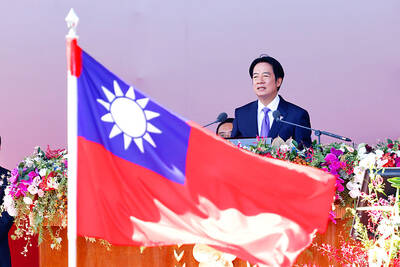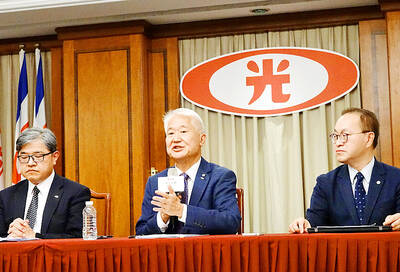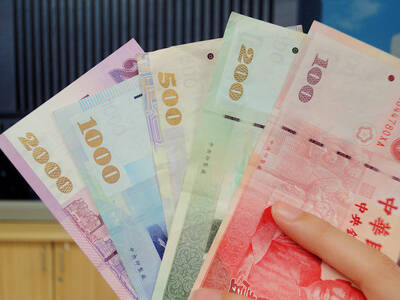Exiled Uighur leader Rebiya Kadeer yesterday said her people face a fight for their very existence against Chinese repression, as a conference in Japan threatened to drive a wedge between Tokyo and Beijing.
In a move that looked likely to provoke China, Kadeer also visited Japan’s Yasukuni shrine, which commemorates those responsible for the brutal 20th-century invasions and occupations in the name of the Japanese emperor.
Ethnic Uighurs and their supporters from around the world gathered in the Japanese capital for a meeting aimed at pressing their claim for freedom from what Kadeer called China’s intensifying crackdown.
“Before, we were fighting for our rights, we were protesting against China’s oppression,” Kadeer said after opening the conference. “But now we face a fight for our existence.”
“The situation is now worse than it was in 2009,” when Uighurs demonstrated and clashed with the Chinese authorities, she said.
Many Uighurs complain that they are the victims of state-sanctioned persecution and marginalization in their homeland in northwest China, aided by the migration of millions of Han Chinese into the territory.
The resulting ethnic tensions have led to sporadic flashes of violence in the Xinjiang region, which is home to 9 million Uighurs.
Kadeer told the meeting that Beijing’s policy of “forcible assimilation” was unacceptable in a modern democracy.
“The Chinese government says it is assimilating and eventually eliminating the Uighur people and other indigenous people ... meanwhile China is becoming a global power,” she said at the opening of the congress.
“We are peacefully struggling and hope the Chinese government will stop the repressing of Uighur people ... and take political reforms to change their authoritarian rule,” she said.
Beijing says it has poured money into Xinjiang in a bid to raise living standards and boost the local economy.
Xinjiang authorities have also announced measures stipulating all businesses and projects hire more ethnic minority workers, but Uighurs say the rules are not always respected.
After the morning session Uighur representatives, including Kadeer, visited Yasukuni.

People can preregister to receive their NT$10,000 (US$325) cash distributed from the central government on Nov. 5 after President William Lai (賴清德) yesterday signed the Special Budget for Strengthening Economic, Social and National Security Resilience, the Executive Yuan told a news conference last night. The special budget, passed by the Legislative Yuan on Friday last week with a cash handout budget of NT$236 billion, was officially submitted to the Executive Yuan and the Presidential Office yesterday afternoon. People can register through the official Web site at https://10000.gov.tw to have the funds deposited into their bank accounts, withdraw the funds at automated teller

PEACE AND STABILITY: Maintaining the cross-strait ‘status quo’ has long been the government’s position, the Ministry of Foreign Affairs said Taiwan is committed to maintaining the cross-strait “status quo” and seeks no escalation of tensions, the Ministry of Foreign Affairs (MOFA) said yesterday, rebutting a Time magazine opinion piece that described President William Lai (賴清德) as a “reckless leader.” The article, titled “The US Must Beware of Taiwan’s Reckless Leader,” was written by Lyle Goldstein, director of the Asia Program at the Washington-based Defense Priorities think tank. Goldstein wrote that Taiwan is “the world’s most dangerous flashpoint” amid ongoing conflicts in the Middle East and Russia’s invasion of Ukraine. He said that the situation in the Taiwan Strait has become less stable

CONCESSION: A Shin Kong official said that the firm was ‘willing to contribute’ to the nation, as the move would enable Nvidia Crop to build its headquarters in Taiwan Shin Kong Life Insurance Co (新光人壽) yesterday said it would relinquish land-use rights, or known as surface rights, for two plots in Taipei’s Beitou District (北投), paving the way for Nvidia Corp to expand its office footprint in Taiwan. The insurer said it made the decision “in the interest of the nation’s greater good” and would not seek compensation from taxpayers for potential future losses, calling the move a gesture to resolve a months-long impasse among the insurer, the Taipei City Government and the US chip giant. “The decision was made on the condition that the Taipei City Government reimburses the related

FRESH LOOK: A committee would gather expert and public input on the themes and visual motifs that would appear on the notes, the central bank governor said The central bank has launched a comprehensive redesign of New Taiwan dollar banknotes to enhance anti-counterfeiting measures, improve accessibility and align the bills with global sustainability standards, Governor Yang Chin-long (楊金龍) told a meeting of the legislature’s Finance Committee yesterday. The overhaul would affect all five denominations — NT$100, NT$200, NT$500, NT$1,000 and NT$2,000 notes — but not coins, Yang said. It would be the first major update to the banknotes in 24 years, as the current series, introduced in 2001, has remained in circulation amid rapid advances in printing technology and security standards. “Updating the notes is essential to safeguard the integrity